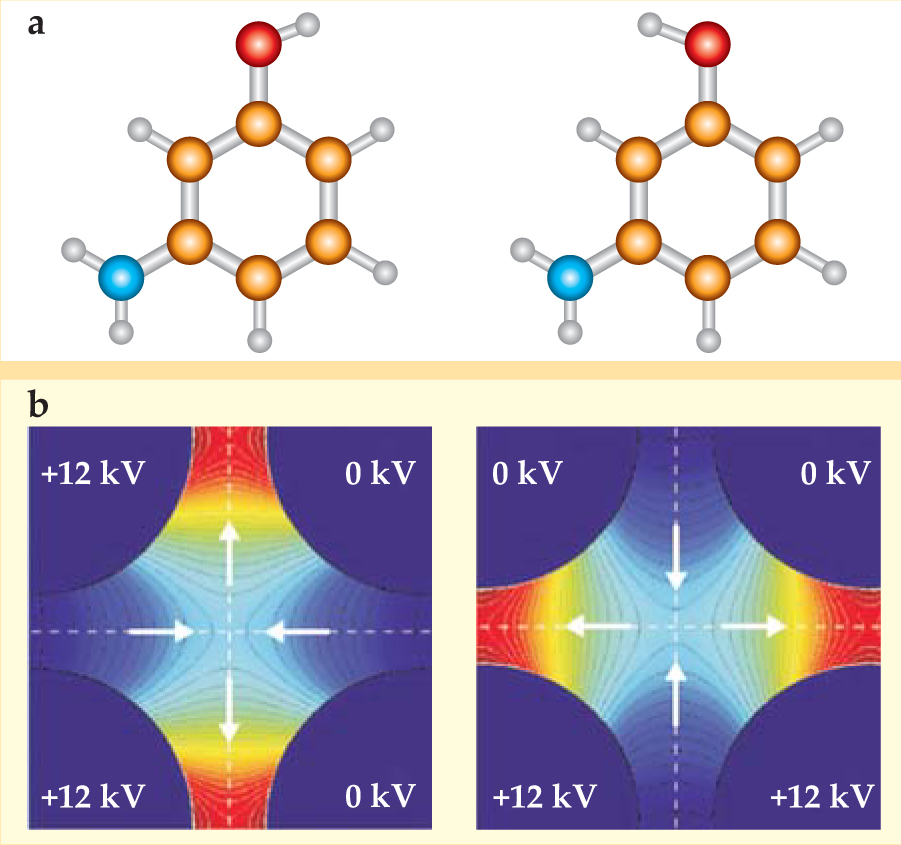Electric-field gradient sorts molecules according to their shape
DOI: 10.1063/1.2947635
Stereoisomers are molecules that have all the same atoms connected in the same way but arranged differently in space. Conformational isomers, or conformers, are stereoisomers that can readily interconvert at room temperature and are typically considered versions of the same molecule. An understanding of conformers is particularly important in the study of biological systems, since a biomolecule’s function is so often related to its physical shape. Protein folding, for example, involves the interconversion of conformers. But it’s difficult to study conformers individually because any room-temperature sample necessarily contains a mix of them, and they respond identically to the usual separation techniques, such as mass spectrometry.
Now, Jochen Küpper, his student Frank Filsinger, and colleagues at the Fritz Haber Institute in Berlin, Germany, have developed a way to spatially separate conformers in a molecular beam. 1 They looked at the cis and trans conformers of the molecule 3-aminophenol, shown in the figure on page 18. As with many biomolecules, the 3AP conformers have very different electric dipole moments, mostly because of the position of the lone pairs of electrons on the oxygen atom. Küpper and colleagues put 3AP into a molecular beam, which cools the internal motions of the molecule enough to suppress the interconversion. They then separated the two conformers using the Stark effect, the shifting of the molecular energies in response to an external electric field.

(a) The conformers of 3-aminophenol: trans-3AP (left) and cis-3AP (right). Carbon atoms are shown in yellow, nitrogen in blue, oxygen in red, and hydrogen in white. Only the position of the uppermost H atom differs between the two structures, but that variation is enough to give them different electric dipole moments. (b) The electric-field configurations used to separate the 3AP conformers. Regions of high electric field are shown in red, and regions of low electric field are shown in blue. The white arrows indicate the directions of the focusing and defocusing forces on the molecules. The frequency of switching between the two configurations determines which conformer is transmitted.
(Adapted from ref. 1.)

Encountering an inhomogeneous electric field, both conformers are drawn to the high-field regions. But cis-3AP, which has a much larger dipole moment than trans-3AP, is pulled more strongly. Küpper and colleagues created their inhomogeneous field using four long, parallel, cylindrical rods, to which they applied voltages that switched between the configurations shown in the figure. The configuration on the left focuses the molecules horizontally and defocuses them vertically, and the configuration on the right does just the opposite. The researchers controlled which molecules were transmitted by adjusting the switching frequency. For a given frequency, molecules of one particular dipole moment are optimally focused, those with lower dipole moments are not focused, and those with higher dipole moments are defocused so much that they escape. For cis-3AP, the optimal switching frequency is around 3 kHz; for trans-3AP, it is around 1.5 kHz.
The selection technique not only sorts the molecules by shape but also facilitates their alignment in space. A molecular beam containing oriented molecules of a single conformer could be useful for studying molecular structure using x-ray or electron diffraction. The use of x rays to determine the shape of a single structure has been demonstrated (see Physics Today, January 2007, page 19
Küpper and colleagues’ method achieves only a partial separation because molecules in high rotational states don’t feel the focusing and defocusing forces as strongly as those in low rotational states. That problem can be lessened, but not entirely eliminated, by decreasing the rotational temperature of the beam. And biomolecules of interest—such as the amino acid phenylalanine, which has at least six conformers with well-separated dipole moments— are not easy to coax into a molecular beam. Says David Pratt of the University of Pittsburgh, “As usual, the devil is in the details. But I am optimistic that the technique will be broadly applicable.”
References
1. F. Filsinger, U. Erlekam, G. von Helden, J. Ku¨pper, G. Meijer, Phys. Rev. Lett. 100, 133003 (2008).https://doi.org/PRLTAO
10.1103/PhysRevLett.100.133003
